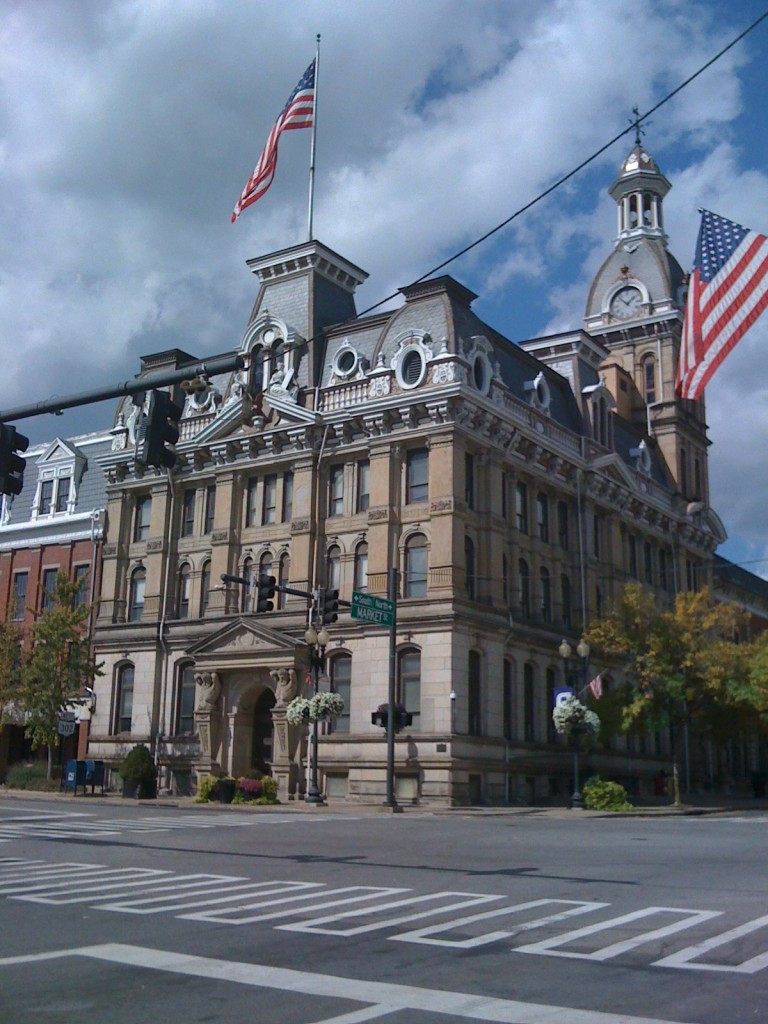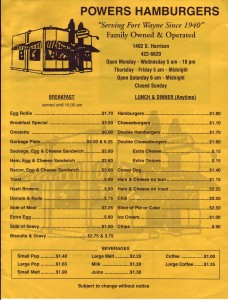Recently I attended a convention in Massillon–always a pleasure, since the town, laden with wonderful architecture, sits smack on the Lincoln Highway and I usually manage to drive at least some of this wonderful road there and back. Having grown up just off the Lincoln Highway in Indiana between LaPorte and South Bend, where the main drags are–ahem–called “Lincolnway,” driving old highways is simply in my blood. (More on Indiana’s stretch, which has recently been designated a state scenic byway, another day.) In recent years, going to this particular convention has given me a good excuse to explore thoroughly our neighboring state’s stretch of this historic road.
Van Wert is the first town of consequence, if you are following the Lincoln Highway eastward from Indiana. A county seat, it boasts an over-the-top nineteenth century courthouse and other wonderful downtown delights. In the next block from the courthouse is Balyeat’s (Balyeats Coffee Shop ). It has an incredible oversized neon sign decades old offering “young fried chicken,” which borders on the horrifying today, but is so darn cool! In truth we did not stop there on the way eastward, but did catch it on the way back, shortly before its closing on Sunday night. They’d had a big day and were out of a lot of food, but what they served–basic American homecooking fare–certainly made me want to go back another time. Besides, did I mention how cool the sign is? Balyeat’s atmosphere and location right across from that courthouse is the kind of place where you can imagine all the town’s moving and shaking has been going on–well, since 1924.

The Wayne County courthouse in Wooster is the only one I have seen in all my travels that is part of a city block, not set apart. (The Steuben County courthouse in Angola, Indiana sits in a corner of the square, but it is still a separate building.) This amazing Second Empire monument to excess was built 1877-79. My jaw still drops.
This intersection lies north of a sort of square on which is located one of the most charming places to plot a revolution I’ve ever encountered. (And from its window one can gaze at the courthouse.) The Tulipan Hungarian Pastry & Coffee Shop is likely as close to Budapest as I’ll ever get. The pastries and Hungarian delicacies inspire rapturous praise. I have tasted nothing ordinary here, let alone bad. While the selections of pastries are vast, Tulipan also offers a menu of entrees that includes delicious open-face sandwiches and rolled omelets, something I had not ever seen before. Light, savory, and deceptively filling, I recommend them all. We stopped there for some pastry (it’s only 20-odd miles from Massillon) and kept to our plan of stopping there for lunch on the way home. The only problem is that it has such a wonderful feel about it that it is difficult to leave.
Massillon, our destination and site of an annual classic film convention in the fall, is a wonderfully historic town, on a river and formerly on a canal, with all the above-ground archaeology associated with such a past. I had always passed and looked longingly at this interesting little drive-in on the west side of town, but this time finally stopped. It was a delightful surprise to discover it offered not only an array of ice cream treats, but a sizable food menu that included a variety of tasty sandwiches and salads.

A little research after my return home revealed that there are a number of these buildings around the country, with several in Ohio. (Read about them here Twistee Treat). Ironically, I had happened to spot one in Niagara Falls earlier this year.
Oh, so many wonders on Ohio’s Lincoln Highway! The return trip included that stop back in Wooster at Tulipan–and also a stolen hour at an amazing bookstore half a block away called Books in Stock (Books In Stock: Used, Rare and Antique Books) that is a dangerous place (you will never get away!) But there is one more food stop I must mention.
The stretch of the old highway between Wooster and Mansfield is especially beautiful. Just east of Mansfield is the tiny village of Mifflin. Its main business is the Mifflin Lakes Trading Post, which is one of the few places you may hear someone order 3 dozen nightcrawlers and two scoops of chocolate ice cream. The storekeeper does wash thoroughly between orders. This place has a huge supply of every sort of bait and lure you could possibly imagine, along with hunting gear I’ve never dreamed of–and ice cream. Good ice cream, never mind the crickets.
Old highways, as I said, are in my blood, and the Lincoln Highway never stops calling me. There is a stretch of the road in Ohio I’ve not yet seen, from Massillon to East Liverpool (home of all that wonderful pottery). I’m going back later this month. You can bet there will be a stop at Tulipan!




